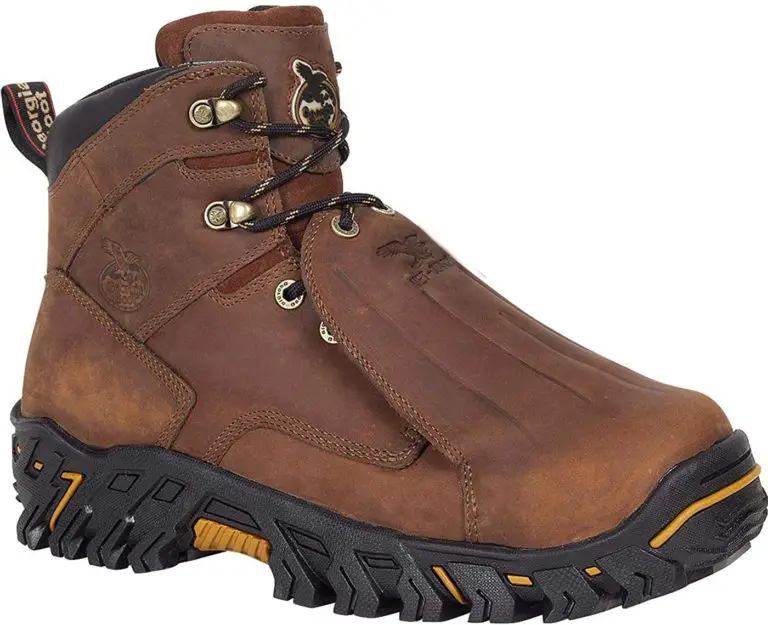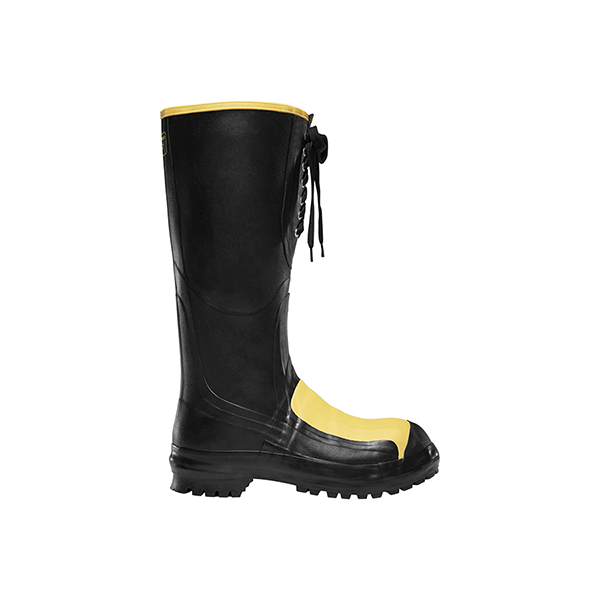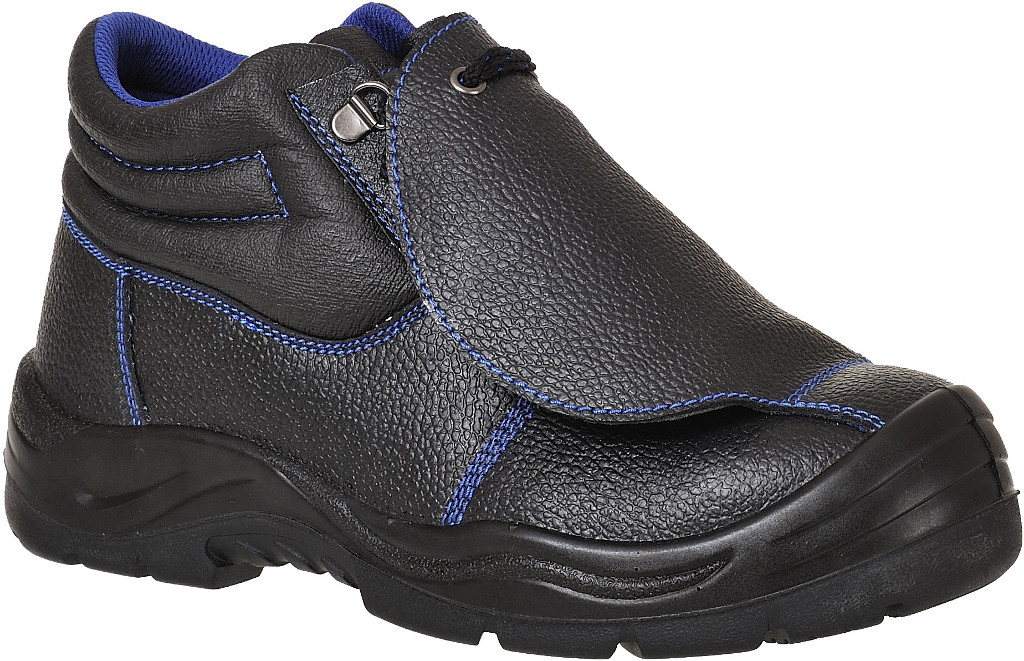What are Met Guard Work Boots and Why You Need Them?
Metatarsal protection in work boots is crucial for safeguarding the delicate bones in the top of your foot. A metatarsal guard, often shortened to met guard, is a protective element incorporated into the boot’s design. This guard is strategically positioned over the metatarsal bones. Its primary purpose is to shield these bones from impact and compression injuries. Without such protection, workers risk severe pain, fractures, and long-term mobility issues. What is a met guard boot? It is more than just a sturdy shoe. It’s a safeguard against workplace accidents.
Workplace hazards are varied. Falling objects can land on feet with considerable force. Heavy equipment may accidentally roll over a foot. These are just a few scenarios where the need for metatarsal protection becomes evident. Industries such as construction, manufacturing, and warehousing commonly present such risks. These environments often involve heavy machinery, materials, and equipment, all posing threats to foot health. Therefore, understanding what is a met guard boot and its importance is essential for workers in these high-risk sectors.
Deciphering Metatarsal Protection: Internal vs External Guards
When exploring what is a met guard boot, it’s crucial to understand the two primary types of metatarsal guards: internal and external. External metatarsal guards are visible, typically a hard cap affixed to the outside of the boot, extending from the toe area back towards the laces. They are usually constructed from materials such as steel, composite, or heavy-duty plastic. This external design offers robust protection against impacts, as the force is absorbed by the guard itself. However, external guards can sometimes be bulky, potentially impacting the wearer’s flexibility and adding weight. The presence of the external guard is very obvious when you see what is a met guard boot.
Internal metatarsal guards, on the other hand, are integrated within the boot’s structure. These guards are often made of similar materials as their external counterparts, such as steel or composite, but they’re embedded beneath the leather or other outer materials. The internal design aims to maintain a smoother profile, enhancing flexibility and reducing the added weight experienced with external guards. While internal guards provide less obvious protection, they can still effectively deflect and dissipate the force of falling objects or compression. The choice between external and internal guards often boils down to the specific job requirements, desired level of flexibility, and the comfort preferences of the wearer. When considering what is a met guard boot, the type of guard is a vital factor in the decision.
Ultimately, the ideal choice depends on the balance of protection, comfort, and practicality required for the wearer’s specific tasks and work conditions. Whether an external or internal guard is selected, both types are designed to provide critical protection against workplace hazards, ensuring safety when working in high-risk environments. Understanding these fundamental differences is crucial when choosing what is a met guard boot that best suits your needs.

The Importance of ANSI Standards and Compliance
Understanding the role of safety standards is crucial when selecting protective footwear. The American National Standards Institute (ANSI) develops these standards. They ensure that safety equipment meets minimum performance requirements. For metatarsal protection in work boots, standards specify testing methods and minimum levels of impact and compression resistance. These standards guarantee that a product labeled with a specific rating offers the stated level of protection. Other regions may have their own relevant local or international standards to follow as well. Manufacturers who adhere to these standards undergo rigorous testing to verify their product’s effectiveness. Failing to meet the necessary requirements would mean that the product would not be certified. This ensures that when you purchase a “what is a met guard boot” designed to protect your feet, you can trust its protective capabilities.
When purchasing metatarsal boots, checking for ANSI compliance is essential. Look for a label, tag, or stamp, usually on the inside of the boot or on the packaging, that indicates the boot meets the relevant standard. The rating often includes a code. This code represents the level of protection provided, including impact resistance. It also includes compression resistance. For example, an ANSI rating may be represented with an indication of the impact and compression level that the boot has been tested against. It is important to understand that this code is the way to properly interpret the minimum level of protection the “what is a met guard boot” will provide. It allows you to make an informed decision. Always consult the manufacturer’s information and materials for a full understanding of what the symbols mean. This ensures you are selecting a boot appropriate for your workplace’s specific hazards.
Additionally, the certification process involves independent third-party testing facilities that verify the manufacturers’ claims. These facilities rigorously assess the metatarsal guards. They evaluate how effective the guards are in preventing injuries during impact and compression scenarios. A boot that has achieved certification through a recognized laboratory will provide peace of mind knowing that you can trust the product. Therefore, selecting a boot that not only carries the “what is a met guard boot” description but is also certified, is key for a safe working environment. By taking the time to check for safety ratings and certifications, one can ensure the right protection level. It’s also a proof that the boot meets necessary safety standards for the job. Always consider this in the purchase process to keep safe at work.
Who Needs Metatarsal Boots? Identifying High-Risk Occupations
Many professions expose workers to significant risks of foot injuries. These injuries often result from impact or compression. Workers in construction frequently handle heavy materials. The possibility of dropped objects is a constant concern. Similarly, manufacturing environments can present crushing hazards. Large machinery or heavy parts can cause severe damage. Therefore, understanding what is a met guard boot becomes crucial for these individuals. Warehousing and logistics personnel are also at high risk. The movement of goods using forklifts and other equipment increases the likelihood of accidents. These work conditions demand proper foot protection. These workers face daily challenges that make metatarsal protection a necessity.
Specific roles such as construction laborers must have metatarsal boots. Ironworkers working at great heights also need them. Factory workers handling heavy machinery need this protection. Warehouse workers moving heavy pallets need this feature. Those working in mining and excavation should also wear met guard boots. It’s important to consider that even seemingly low-risk jobs can pose dangers. Any job where there’s a risk of heavy objects falling is a risk. Any workplace with compression hazards also has a great need for this equipment. A what is a met guard boot concept must be understood by those responsible for worker safety. The investment in these safety boots directly reduces foot injuries. These boots protect from life-changing injuries and help keep workers safe and productive. Therefore, metatarsal boots are essential for these high-risk jobs.
Beyond these well-known examples, other industries also benefit from metatarsal protection. Oil and gas, transportation, and heavy equipment operation, all present unique dangers. Mechanics and technicians working with heavy tools also need them. Emergency responders, like firefighters, might also benefit. Their line of work has exposure to falling debris and extreme conditions. These individuals work in unpredictable environments that make the use of safety boots vital. Proper training on what is a met guard boot and when to wear them are critical. It ensures that workers are aware of the necessary safety measures. When properly used, the impact from these situations is considerably reduced. For these roles, safety footwear is a necessity, not just an option. A proactive approach to safety always helps to prevent injuries.

How to Choose the Right Metatarsal Work Boot for Your Needs
Selecting the appropriate metatarsal guard boot requires careful consideration of several factors. Begin by evaluating the specific work environment. What hazards are present? Are there risks of falling objects or compression? Understanding the potential threats is key. Then, consider the specific requirements of the job. A construction worker might face different risks than a warehouse employee. Comfort preferences also play a vital role. A boot that is comfortable for the user will be worn more consistently, providing the necessary protection. The question to always consider is: “what is a met guard boot” and how well it fits the job needed?
Trying on boots is crucial for finding the right fit. Ensure there is enough room in the toe box. Too much or too little space can lead to discomfort and injury. Walk around in the boots. Assess their weight and flexibility. A bulky, inflexible boot can hinder movement and cause fatigue. Consider the materials used in construction. This aspect affects both durability and comfort. Evaluate how well the chosen boot meets the specific demands of the work being done. This practical approach helps to find a metatarsal boot that provides both effective protection and daily comfort. Remember, a properly fitted boot makes a significant difference in safety and performance.
When evaluating a “what is a met guard boot” for purchase, pay attention to its overall design. Note how the metatarsal guard is integrated. Is it internal or external? This affects the flexibility and the boot’s overall shape. Consider the boot’s weight. A lighter boot may be more comfortable for prolonged wear. But do not compromise on the needed protection. Finally, consider the other features of the boot. Check for adequate ankle support and a secure lacing system. A metatarsal guard boot that combines safety, comfort, and good fit will ensure protection all day long.
Key Features to Consider When Selecting Metatarsal Safety Boots
When selecting what is a met guard boot, several key features extend beyond just the metatarsal protection. The outsole material is crucial, offering varied levels of slip resistance. Look for outsoles made from rubber or other high-traction compounds. This ensures a firm grip on diverse surfaces, minimizing the risk of slips and falls. Puncture resistance is another critical aspect, preventing sharp objects from penetrating the sole. Consider work boots with puncture-resistant midsoles, particularly if you’re working in environments with nails, glass, or other sharp debris. Electrical hazard protection is vital for those working near electrical circuits or equipment. Boots marked with “EH” indicate they meet the standards for electrical hazard resistance. These safety ratings are imperative for worker safety. The construction of the boot itself also plays a major role. High-quality stitching and durable materials contribute to a longer lifespan. Paying attention to these details is crucial when choosing a metatarsal boot.
Beyond these protective features, comfort and durability are important when deciding what is a met guard boot. Consider additional properties such as waterproofing and breathability if you work in diverse weather conditions. Boots with waterproof membranes keep your feet dry, while breathable materials help to wick away moisture, ensuring comfort throughout long workdays. The type of job requirements heavily influence the priority of these features. For instance, someone working in a construction site will benefit from puncture resistance and slip resistance and someone in electrical will need the EH properties. Consider what work environment and hazards the user encounters daily to prioritize the right features. A high-quality work boot can make a huge difference in overall job performance and safety. Always assess the specific needs of your work, and then pick accordingly. Proper construction enhances the boot’s integrity.
Remember that investing in quality safety boots is beneficial for long-term usage. Durability means fewer replacements, thus saving money. Prioritizing safety properties like the ones mentioned ensures overall protection and comfort. What is a met guard boot should not only be protective but also comfortable and suitable for the work environment. By carefully considering each feature, workers can choose metatarsal work boots that match their needs and safety requirements. The right boots will improve work performance while reducing the risk of work related injuries. High quality work boots are a valuable investment in your safety and well-being.

Metatarsal Boot Reviews: A Look at Popular Brands Like Timberland PRO and Carhartt
When exploring options for what is a met guard boot, several reputable brands consistently appear in discussions, with Timberland PRO and Carhartt being among the most favored. Timberland PRO is known for its commitment to crafting durable and comfortable work boots, often incorporating advanced technologies to enhance protection and support. Their metatarsal boots frequently feature robust external guards, ensuring significant impact resistance. Many models boast features like anti-fatigue technology and waterproof membranes, which enhance comfort and usability in challenging work environments. Carhartt, a brand with a strong heritage in workwear, offers metatarsal safety boots that are built to withstand demanding conditions. They commonly use durable materials such as high-quality leather and abrasion-resistant fabrics. Carhartt’s boots are designed to provide reliable protection and long-lasting performance and are well regarded for their rugged construction and practical designs. Both brands offer a variety of styles and models that cater to different job requirements, making them a go-to option for many workers.
The popularity of both Timberland PRO and Carhartt stems from their ability to blend durability with user-friendly designs. While both brands offer excellent options for what is a met guard boot, there are slight variations in their approach. Timberland PRO often focuses on incorporating advanced comfort technologies within their boots, making them suitable for long hours on the job. Carhartt, on the other hand, tends to emphasize the ruggedness and longevity of their products, making them ideal for heavy-duty applications. Both brands provide a variety of options, including boots with internal and external metatarsal guards, allowing users to select based on their personal preferences. While no ranking is made, these brands are considered among the best for their high-quality construction and reliable protection. When considering what is a met guard boot, these two brands represent solid options for durable, high-quality choices.
Ultimately, the choice between Timberland PRO and Carhartt, or other brands, comes down to specific needs and preferences. Evaluating factors such as work environment, types of hazards, desired comfort levels, and specific boot features is important to make the best choice. It is important that, regardless of the brand, the metatarsal boots should comply with the necessary safety standards for adequate protection. When considering what is a met guard boot, take the time to try a few models from various brands, to ensure that you have a good fit and get the best protection for your specific needs. Prioritizing key features ensures that the boots provide the necessary protection and last a long time.
Maintaining and Caring for Your Met Guard Boots: Extending Their Lifespan
Proper care and maintenance are crucial to maximizing the lifespan of metatarsal guard boots. Regular cleaning prevents dirt and grime from compromising the materials. After each use, wipe down the exterior of the boots with a damp cloth. This simple step removes debris that can cause wear and tear. For more stubborn dirt, use a mild soap and water solution. Always allow the boots to air dry thoroughly after cleaning. Avoid using direct heat sources, such as a hairdryer, because this may damage the leather or composite materials. Consider using a leather conditioner to keep leather boots supple and prevent cracking. A well-maintained boot not only looks better, but also retains its protective qualities. The effectiveness of a met guard boot relies on the integrity of its structure and materials.
Storing met guard boots correctly is just as important as regular cleaning. Avoid leaving them in direct sunlight or in extremely hot or cold environments. These conditions can degrade the materials and reduce the boot’s protective capabilities. When not in use, store your met guard boots in a cool, dry place. A well-ventilated area helps prevent moisture build-up, which could lead to mold and mildew. Using a boot tree or insert is a good way to retain the boot’s shape. This prevents creases and keeps the boot comfortable for wear. Remember, what is a met guard boot’s value if it is not well cared for? The metatarsal protection system itself also benefits from consistent maintenance. Check for any signs of damage, such as cracks or loose parts, especially on the metatarsal guard itself. Ignoring these issues could reduce the level of protection the boots offer.
Different materials may require specialized care. For instance, composite guards are generally more resistant to impacts, but their integrity should still be checked periodically. What is a met guard boot made of matters; whether it’s leather, synthetic, or a combination, each material requires a specific approach to maintenance. Always follow the manufacturer’s care instructions for the best results. Replace laces as needed. Damaged laces can compromise the fit, affecting the safety and comfort of the boot. Inspect the outsole for excessive wear, and if the tread is gone, it’s time for new ones. A proactive approach to met guard boot care ensures they will last longer and remain safe and effective. A good maintenance routine makes sure your footwear is always ready to keep your feet safe on the job. This also gives you the value and usefulness you expect when you bought them.

